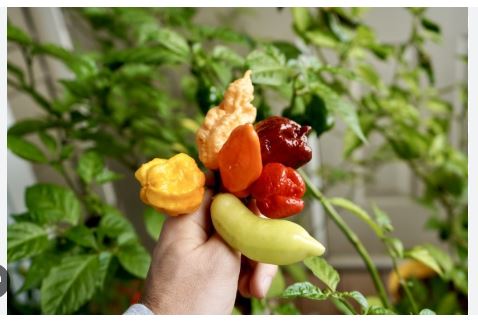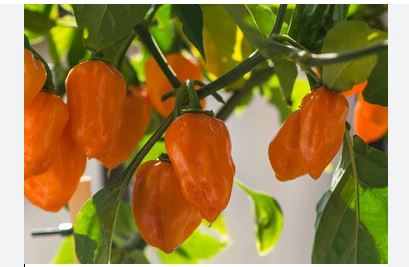
Capsicums, often referred to as peppers or chili peppers, are vibrant fruits belonging to the Capsicum genus within the Solanaceae family. Native to the Americas, their cultivation dates back over 7,500 years, with origins in regions like Mexico, Peru, and Bolivia. Archaeological evidence suggests pre-Columbian societies domesticated these plants long before their introduction to Europe by Christopher Columbus in 1493. From there, capsicums spread globally via trade routes, becoming integral to cuisines in Asia, Africa, and Europe. Today, they are grown worldwide in warm climates, thriving in well-drained, sunny conditions, and celebrated for their diversity in flavor, color, and heat.
The appeal of capsicums lies in their remarkable variety, encompassing five main domesticated species: Capsicum annuum, C. baccatum, C. chinense, C. frutescens, and C. pubescens. These species produce fruits that range from sweet and mild to intensely fiery, with heat levels determined by capsaicin, a compound measured in Scoville Heat Units (SHU). Colors span green, red, yellow, orange, purple, and even black, often shifting as the fruit ripens. Sizes and shapes are equally diverse, from tiny, round berries to large, blocky forms. This versatility makes capsicums a favorite among gardeners and chefs, who prize their ability to enhance dishes with both flavor and visual appeal.
Capsicums are nutritional powerhouses, rich in vitamins A, C, and E, as well as antioxidants like beta-carotene. Their capsaicin content, responsible for spiciness, is also linked to health benefits, including pain relief, improved metabolism, and anti-inflammatory properties. In culinary applications, capsicums shine in countless forms—fresh, dried, pickled, or ground into powders. They add depth to salsas, curries, sauces, and spice blends, with each variety contributing unique notes, from fruity and floral to smoky or earthy. Their adaptability has cemented their role in global cuisines, from Mexican moles to Thai stir-fries and Caribbean jerk dishes.
Cultivating capsicums is rewarding for home gardeners, though they require warmth, ample sunlight, and well-drained soil to thrive. They can be grown in pots or gardens, with seeds often started indoors in cooler climates. Harvesting occurs at different ripeness stages, depending on desired flavor or heat.

Capsicums
Bell Pepper (Capsicum annuum)
Originating in Mexico and Central America, bell peppers were domesticated around 6,000–7,000 years ago and spread to Europe via Christopher Columbus in 1493. Bell peppers are large, blocky, and mild, with no capsaicin, making them sweet (0 SHU). They come in green, red, yellow, orange, and purple hues, with green being unripe and red fully ripened, offering a sweeter flavor. They’re rich in vitamins A and C. Perfect for salads, stir-fries, stuffed dishes, and grilling due to their crisp texture and vibrant colors.
Jalapeño (Capsicum annuum)
Native to Mexico, particularly Veracruz, jalapeños have been cultivated since pre-Columbian times. These medium-sized peppers (2–3 inches) are moderately spicy (2,500–8,000 SHU), with a bright, grassy flavor. Green when immature, they ripen to red. Their thick flesh makes them ideal for cooking. Popular in salsas, nachos, and poppers; dried jalapeños are called chipotle.
Cayenne (Capsicum annuum)
Originating in South America, cayenne peppers were named after the city of Cayenne in French Guiana. Long, thin, and wrinkled, cayennes are fiery (30,000–50,000 SHU) with a sharp, fruity taste. They ripen from green to red and are often dried into powder. Used in hot sauces, spice blends, and medicinal remedies for their capsaicin content.
Poblano (Capsicum annuum)
Hailing from Puebla, Mexico, poblanos are a staple in Mexican cuisine. Large, heart-shaped, and mildly spicy (1,000–1,500 SHU), poblanos are dark green, ripening to red or brown. They have a rich, earthy flavor. Roasted for chile rellenos, stuffed dishes, or dried as ancho chiles for mole sauces.
Serrano (Capsicum annuum)
Native to the Mexican highlands, serranos are named after the Spanish word for “mountainous.” Small, slender, and hotter than jalapeños (10,000–23,000 SHU), serranos are green, ripening to red or yellow. They have a crisp, bright taste. Ideal for fresh salsas, pico de gallo, and hot sauces.
Anaheim (Capsicum annuum)
Developed in New Mexico, USA, Anaheim peppers were named after the California city. Long, mild peppers (500–2,500 SHU) with a sweet, slightly tangy flavor. Green when young, they ripen to red. Roasted, stuffed, or used in green chile sauces; dried as chile seco del norte.
Habanero (Capsicum chinense)
Originating in the Amazon Basin, habaneros spread to the Caribbean and Yucatán Peninsula. Small, wrinkled, and intensely hot (100,000–350,000 SHU), habaneros have a fruity, citrusy flavor. They range from green to orange, red, or purple. Used sparingly in salsas, hot sauces, and Caribbean jerk dishes.
Scotch Bonnet (Capsicum chinense)
Native to the Caribbean, particularly Jamaica, Scotch Bonnets are central to island cuisines. Wrinkled, round, and fiery (100,000–350,000 SHU), they offer a sweet, tropical flavor. Colors include green, red, and yellow. Essential in jerk seasoning, hot sauces, and Caribbean stews.
Thai Chili (Capsicum annuum)
Originating in Southeast Asia, Thai chilis were introduced from the Americas via Portuguese traders. Tiny, slender, and very spicy (50,000–100,000 SHU), they ripen from green to red with a sharp, clean heat. Common in Thai curries, stir-fries, and chili pastes like nam prik.
Tabasco (Capsicum frutescens)
Native to Central and South America, Tabasco peppers are famously grown in Louisiana, USA. Small, juicy, and moderately hot (30,000–50,000 SHU), they ripen from yellow to red. Their thin skin makes them ideal for sauces. The primary ingredient in Tabasco sauce; also used in vinegars and pickles.
Aji Amarillo (Capsicum baccatum)
Domesticated in Peru around 2,500 BC, aji amarillo is a cornerstone of Peruvian cuisine. Bright yellow-orange, moderately spicy (30,000–50,000 SHU), with a fruity, berry-like flavor. They’re long and wrinkled. Used in Peruvian ceviches, sauces, and stews like aji de gallina.
Rocoto (Capsicum pubescens)
Originating in the Andes of Bolivia and Peru, rocotos were domesticated 5,000 years ago. Round, juicy, and very hot (50,000–250,000 SHU), with black seeds and hairy leaves. They ripen to red, yellow, or orange. Used in salsas, stuffed dishes, and Andean hot sauces.
Banana Pepper (Capsicum annuum)
Native to South America, banana peppers are widely grown in the USA. Long, curved, and mild (0–500 SHU), with a tangy, sweet flavor. They’re yellow, ripening to red or orange. Pickled for sandwiches, salads, or pizza toppings.
Pimento (Capsicum annuum)
Likely from Central America, pimentos were popularized in Spain and the USA. Heart-shaped, sweet, and mild (0–500 SHU), with thick, red flesh. They’re often canned or dried. Stuffed in olives, used in pimento cheese, or ground into paprika.
Cubanelle (Capsicum annuum)
Originating in the Caribbean, Cubanelles are popular in Latin American cuisines. Long, tapered, and mild (100–1,000 SHU), with a sweet, crisp flavor. They’re green, ripening to red or yellow. Fried, roasted, or used in sofrito and stuffed dishes.
Shishito (Capsicum annuum)
Native to Japan, shishitos likely descended from South American peppers. Small, wrinkled, and mostly mild (50–200 SHU), though one in ten is spicy. They’re green, ripening to red. Blistered or grilled as a snack or appetizer.
Ghost Pepper (Bhut Jolokia) (Capsicum chinense)
Native to Northeast India, ghost peppers were domesticated over 7,000 years ago. Wrinkled, red, and extremely hot (800,000–1,000,000 SHU), with a smoky, fruity flavor. Used cautiously in hot sauces, curries, and spicy challenges.
Carolina Reaper (Capsicum chinense)
Developed in South Carolina, USA, by breeder Ed Currie, it’s a hybrid of ghost pepper and habanero. Small, gnarled, and blisteringly hot (1,500,000–2,200,000 SHU), with a sweet, fruity undertone. Red when ripe. Used in extreme hot sauces and chili-eating competitions.
Fresno (Capsicum annuum)
Bred in California, USA, Fresno peppers are a modern cultivar. Similar to jalapeños but hotter (2,500–10,000 SHU), with a fruity, smoky flavor. Green to red when ripe. Great for salsas, hot sauces, and roasting.
Chiltepin (Capsicum annuum)
Native to Mexico and the southwestern USA, chiltepins are wild ancestral peppers. Tiny, round, and very hot (50,000–100,000 SHU), with a sharp, fleeting heat. They ripen from green to red. Dried for spices, used in salsas, or eaten fresh in small amounts.
Peppadew (Capsicum baccatum)
Discovered in South Africa, Peppadew is a trademarked cultivar of C. baccatum. Small, round, and mildly spicy (1,000–1,500 SHU), with a sweet, tangy flavor. Red when ripe. Pickled as a snack, stuffed with cheese, or used in salads.
Mirasol (Capsicum annuum)
Native to Mexico, Mirasol peppers grow upward, unlike most peppers. Bright red, moderately hot (2,500–5,000 SHU), with a fruity, earthy taste. Dried, they’re called guajillo. Used in Mexican moles, sauces, and spice blends.
Piri Piri (Capsicum frutescens)
Originating in South America, piri piri peppers are popular in African and Portuguese cuisines. Small, fiery (50,000–175,000 SHU), with a clean, sharp heat. They ripen to red or purple. Used in piri piri sauce, marinades, and grilled dishes.
Manzano (Capsicum pubescens)
Native to the Andes, manzano peppers are grown in high-altitude regions. Apple-shaped, juicy, and hot (30,000–100,000 SHU), with black seeds and a fruity flavor. They ripen to red or yellow. Used in fresh salsas, hot sauces, and roasted dishes in Andean cuisine.